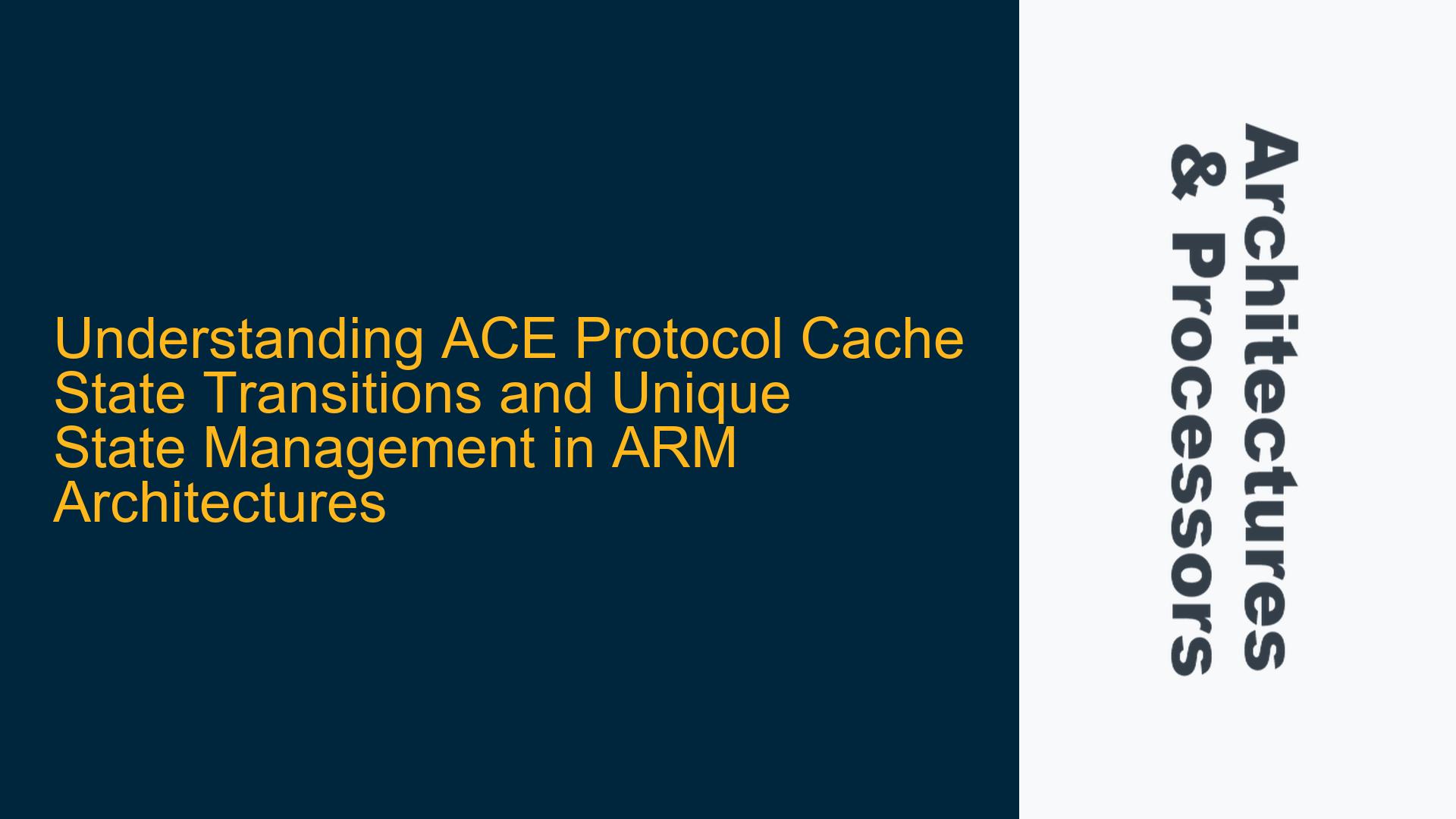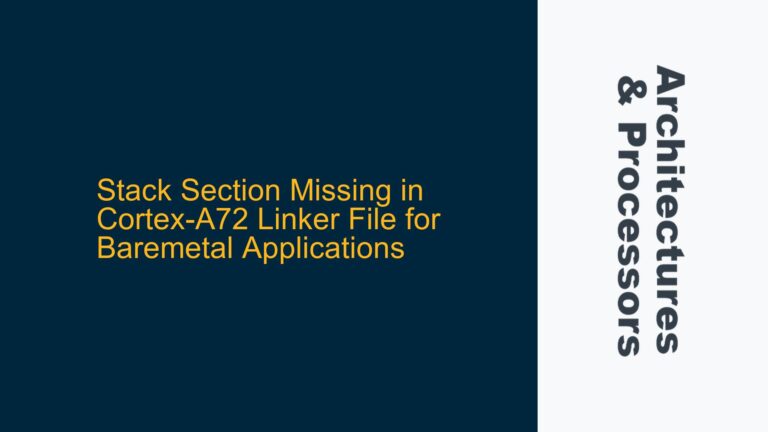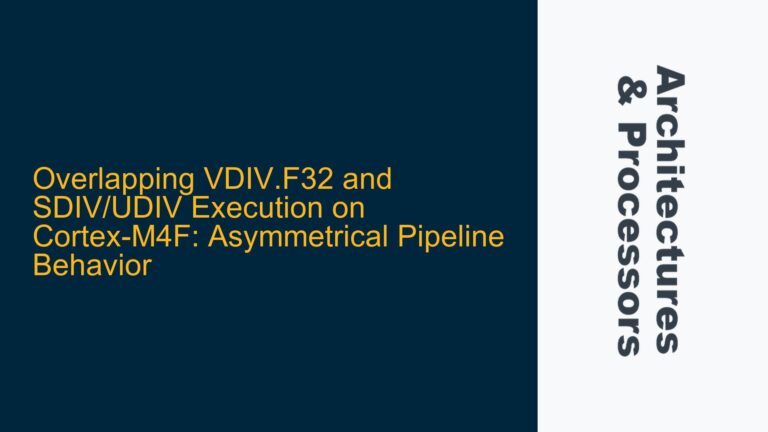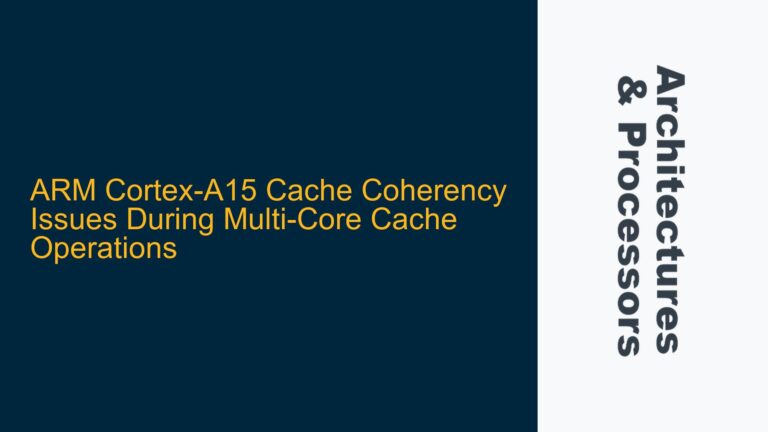ARM Cortex-A Series Cache Coherency and ACE Protocol Behavior
The ARM Cortex-A series processors utilize the ACE (AXI Coherency Extensions) protocol to maintain cache coherency across multiple masters in a system. Cache coherency is critical in multi-core systems where multiple processors or DMA controllers may access shared memory. The ACE protocol ensures that all masters have a consistent view of memory by managing cache states and coordinating transactions between caches.
In the ACE protocol, cache lines can exist in various states, including Unique, Shared, and Invalid. The Unique state indicates that a master has exclusive ownership of a cache line, meaning no other master holds a copy. The Shared state indicates that multiple masters may hold copies of the cache line, and the Invalid state means the cache line is not valid and must be fetched from memory or another cache.
A key challenge in ACE-based systems is ensuring that masters correctly interpret and manage cache states, particularly during transactions that involve snooping and cache line state transitions. Misunderstanding or mishandling these states can lead to coherency violations, stale data, or performance bottlenecks.
Snoop Responses and Cache State Determination in ACE
The ACE protocol relies on snoop responses to determine the state of cache lines across masters. When a master initiates a transaction, the interconnect broadcasts snoop requests to other masters to determine if they hold copies of the requested cache line. The responses from these snoops, specifically the CRRESP.IsShared signal, dictate how the requesting master should allocate the cache line.
If no other master indicates that it holds a copy of the cache line (CRRESP.IsShared == 0), the requesting master can allocate the cache line in the Unique state. This indicates exclusive ownership, allowing the master to modify the cache line without notifying other masters. However, if any master responds with CRRESP.IsShared == 1, the requesting master must allocate the cache line in the Shared state, indicating that other masters may also hold copies.
The RRESP[3] signal plays a critical role in this process. It is used by the interconnect to inform the requesting master whether the cache line should be allocated as Unique or Shared. This decision is based on the snoop responses and ensures that cache coherency is maintained across the system.
Implementing Cache State Management and Snoop Handling in ACE Systems
To ensure proper cache state management in ACE-based systems, developers must carefully implement snoop handling and cache state transitions. Below are detailed steps and considerations for achieving this:
1. Understanding Snoop Types and Their Impact on Cache States
The ACE protocol defines several snoop types, including ReadOnce, CleanShared, and others. Each snoop type has specific implications for cache state transitions. For example, ReadOnce snoops do not change the cache state of the snooped master, while CleanShared snoops require the snooped master to transition its cache line to the Shared or Invalid state.
Developers must ensure that their cache controllers correctly handle each snoop type and update cache states accordingly. Failure to do so can result in coherency violations or unnecessary cache line invalidations.
2. Proper Use of Memory Barriers and Synchronization Primitives
Memory barriers and synchronization primitives are essential for ensuring that cache state transitions occur in the correct order. For example, a Data Synchronization Barrier (DSB) can be used to ensure that all pending cache operations are completed before proceeding with subsequent instructions. This is particularly important in scenarios where a master transitions a cache line from Unique to Shared or Invalid.
Developers should also use appropriate synchronization primitives, such as spinlocks or semaphores, to coordinate access to shared resources between masters. This prevents race conditions and ensures that cache state transitions are atomic.
3. Monitoring and Debugging Cache Coherency Issues
Cache coherency issues can be challenging to diagnose due to their intermittent nature and the complexity of multi-core systems. Developers should use tools such as ARM CoreSight or custom logging mechanisms to monitor cache state transitions and snoop responses.
When debugging coherency issues, it is important to verify that all masters are correctly interpreting snoop responses and updating cache states. Additionally, developers should check for potential issues such as missing memory barriers or incorrect use of synchronization primitives.
4. Optimizing Cache Performance in ACE Systems
While maintaining cache coherency is critical, developers should also consider performance implications. For example, excessive snooping or cache line invalidations can degrade system performance. To mitigate this, developers can optimize cache line usage by aligning data structures to cache line boundaries and minimizing false sharing.
Additionally, developers should consider the impact of cache state transitions on system performance. For example, transitioning a cache line from Unique to Shared may require additional bus transactions, which can increase latency. By carefully managing cache states and minimizing unnecessary transitions, developers can improve system performance.
5. Leveraging ACE Protocol Features for Advanced Use Cases
The ACE protocol provides several advanced features that can be leveraged for specific use cases. For example, the DVM (Distributed Virtual Memory) extensions enable coherency across multiple clusters or systems. Developers should familiarize themselves with these features and consider their applicability to their specific use cases.
Additionally, developers should stay updated on the latest revisions of the ACE specification, as new features and optimizations may be introduced. For example, the ACE 5 specification introduced enhancements to snoop filtering and cache state management, which can improve performance and reduce power consumption.
Summary of Key Considerations
To summarize, proper cache state management in ACE-based systems requires a deep understanding of the ACE protocol, careful implementation of snoop handling and cache state transitions, and the use of appropriate tools and techniques for monitoring and debugging. By following these guidelines, developers can ensure cache coherency, optimize system performance, and leverage advanced ACE protocol features for their specific use cases.
Table: ACE Snoop Types and Cache State Transitions
| Snoop Type | Description | Cache State Transition |
|---|---|---|
| ReadOnce | Non-intrusive read operation; does not change cache state | No change |
| CleanShared | Ensures cache line is clean and shared; transitions to Shared or Invalid | Shared or Invalid |
| ReadClean | Reads clean data; transitions to Shared or Invalid | Shared or Invalid |
| ReadNotSharedDirty | Reads data that is not shared or dirty; transitions to Shared or Invalid | Shared or Invalid |
| ReadUnique | Reads data exclusively; transitions to Unique | Unique |
This table provides a quick reference for the impact of different snoop types on cache state transitions. Developers should use this information to ensure that their cache controllers correctly handle each snoop type and maintain coherency across the system.
By addressing these aspects, developers can effectively manage cache states in ACE-based systems, ensuring coherency, performance, and reliability.






